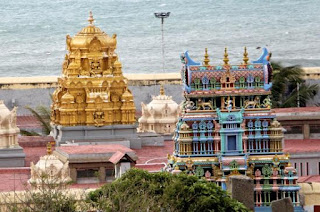 |
| Kanyakumari Amman vijiravindran.com |
The Kanyakumari Devi Temple, also known as the Kumari Amman Temple or Bhagavathy Amman Temple, is a highly revered Hindu shrine dedicated to Goddess Bhagavathy, or Devi Kanya Kumari, a virgin goddess in her adolescent child form and an aspect of Sakthi (Durga or Parvati). The temple is located at the absolute southern tip of peninsular India, where the three seas—the Bay of Bengal, the Arabian Sea, and the Indian Ocean—meet. It is one of the 51 Shakti Peetams, believed to be the spot where the spine area of Sati’s corpse fell, creating kundalini sakthi. Legend has it that Sage Parashurama himself performed the consecration of the temple. The mythology surrounding the temple tells of the demon king Asura Bana, who could only be killed by a virgin. Goddess Kanya Kumari agreed to marry Lord Shiva, but Sage Narada, knowing the demon's boon, purposely delayed Shiva on his way from Susheendram, making him miss the auspicious marriage time (Brahma muhurtam). The wedding was canceled, and the disappointed Devi chose to remain a Kanni (virgin). When Banasura approached her, she killed him, thus restoring order. The temple finds mention in the Ramayana, Mahabharata, Sangam works (Manimekalai, Puranaanooru), and the Narayana Upanishad. The presiding deity, in a standing posture facing east, possesses an exquisite diamond nose ring. This nose ring’s intense reflection is the reason the temple's eastern gate is kept closed most of the time—to prevent mariners from mistaking its glimmer for a lighthouse and crashing their ships on the rocks. The main access to the temple is through the northern gateway. The place has deep spiritual connections, most famously with Swami Vivekananda, who visited and meditated on a nearby rock outcrop in December 1892, acting on the advice of his Guru, Sri Ramakrishna Paramahamsa, to seek the Devi's blessing. Other disciples like Swami Brahmananda and Swami Nirmalananda also worshipped the Goddess, with Swami Nirmalananda later training the girls who would become the first batch of Nuns of the Sarada Ashrama. The rites and rituals of the temple were organized and classified by the philosopher Sankarachariyar. Kalabhairava is worshipped here as Nimish, with the Shakti as Sarvani. The temple celebrates major festivals like the nine-day Navaratri (Sept-Oct). A unique spectacle is the simultaneous setting of the sun in the west and the rising of the moon in the east on full moon days.












